2011 HYUNDAI VERACRUZ cargo
[x] Cancel search: cargoPage 22 of 419
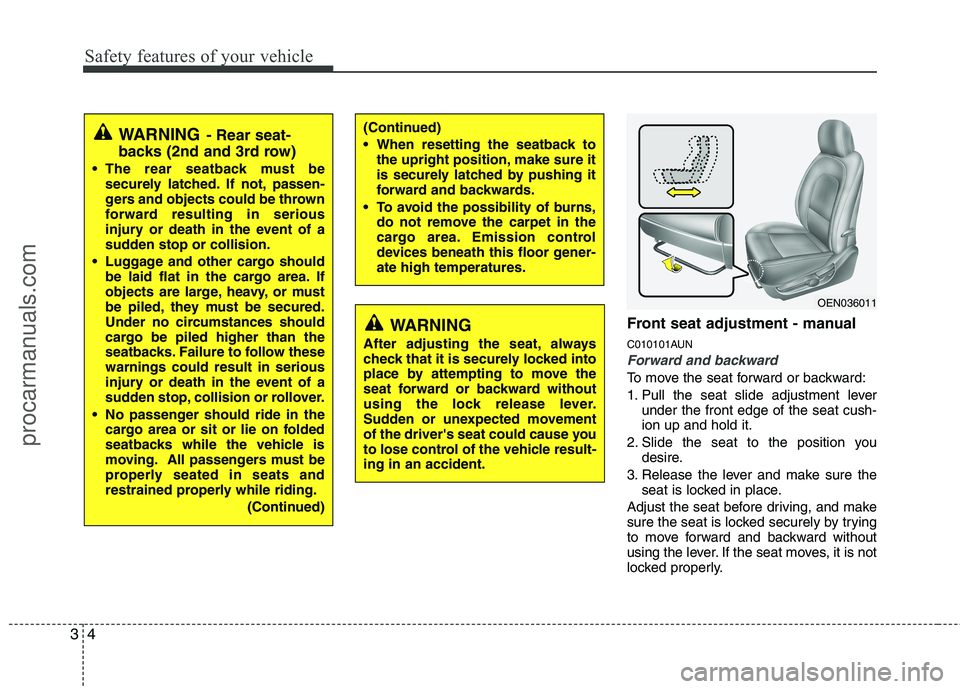
Safety features of your vehicle
4
3
Front seat adjustment - manual
C010101AUN
Forward and backward
To move the seat forward or backward:
1. Pull the seat slide adjustment lever
under the front edge of the seat cush- ion up and hold it.
2. Slide the seat to the position you desire.
3. Release the lever and make sure the seat is locked in place.
Adjust the seat before driving, and make
sure the seat is locked securely by trying
to move forward and backward without
using the lever. If the seat moves, it is not
locked properly.
OEN036011
(Continued)
When resetting the seatback to the upright position, make sure it
is securely latched by pushing it
forward and backwards.
To avoid the possibility of burns, do not remove the carpet in the
cargo area. Emission control
devices beneath this floor gener-ate high temperatures.WARNING - Rear seat-
backs (2nd and 3rd row)
The rear seatback must be securely latched. If not, passen-
gers and objects could be thrown
forward resulting in serious
injury or death in the event of a
sudden stop or collision.
Luggage and other cargo should be laid flat in the cargo area. If
objects are large, heavy, or must
be piled, they must be secured.
Under no circumstances should
cargo be piled higher than the
seatbacks. Failure to follow thesewarnings could result in serious
injury or death in the event of a
sudden stop, collision or rollover.
No passenger should ride in the cargo area or sit or lie on folded
seatbacks while the vehicle is
moving. All passengers must be
properly seated in seats and
restrained properly while riding.
(Continued)
WARNING
After adjusting the seat, always
check that it is securely locked into
place by attempting to move the
seat forward or backward without
using the lock release lever.
Sudden or unexpected movement
of the driver's seat could cause you
to lose control of the vehicle result-ing in an accident.
procarmanuals.com
Page 34 of 419

Safety features of your vehicle
16
3
C010307AEN
Folding the rear seat
The rear seatbacks may be folded to
facilitate carrying long items or toincrease the luggage capacity of the
vehicle. To fold down the rear seatback:
1. Insert the rear seat belt buckle in the
pocket between the rear seatback
and cushion, and insert the rear seat
belt webbing in the guide to preventthe seat belt from being damaged.
2. Set the front (or 2nd row) seatback to the upright position and if necessary,
slide the front (or 2nd row) seat for-
ward.
3. Lower the rear headrests to the lowest position.
4. Pull on the seatback folding lever, thenfold the seat toward the front of the
vehicle. When you return the seatback
to its upright position, always be sure it
has locked into position by pushing on
the top of the seatback.
OEN036025
OEN037026
■2nd row seat
■3rd row seat
WARNING
The purpose of the fold-down rear
seatbacks is to allow you to carry
longer objects that could not be
accommodated in the cargo area.
Never allow passengers to sit on
top of the folded down seatback
while the car is moving as this is
not a proper seating position and
no seat belts are available for use.
This could result in serious injuryor death in case of an accident or
sudden stop. Objects carried on the
folded down seatback should not
extend higher than the top of the
front seatbacks. Doing this could
allow cargo to slide forward and
cause injury or damage during sud-den stops.
procarmanuals.com
Page 35 of 419

317
Safety features of your vehicle
5. To use the rear seat, lift and pull theseatback backward by pulling on the
folding lever. Pull the seatback firmly
until it clicks into place. Make sure the
seatback is locked in place.
6. Return the rear seat belt to the proper position.
WARNING
When you return the rear seatback to its upright position after being
folded down:
Be careful not to damage the seat
belt webbing or buckle. Do not
allow the seat belt webbing or
buckle to get caught or pinched in
the rear seat. Ensure that the seat-
back is completely locked into its
upright position by pushing on the
top of the seatback. Otherwise, in
an accident or sudden stop, the
seat could fold down and allow
cargo to enter the passenger com-
partment, which could result in
serious injury or death.
OUN026140
WARNING - 3rd row seat
The headrest on the 3rd row seat should be adjusted to the upper
position and locked when the occu-pant is seated.
If the tailgate is pushed down to
close it when a passenger's head is
not against a properly adjusted
headrest or a tall person is seated,
the tailgate may hit the occupant's
head, which could cause injury.
OEN036027
OEN037028
■ 2nd row seat
■3rd row seat
procarmanuals.com
Page 36 of 419
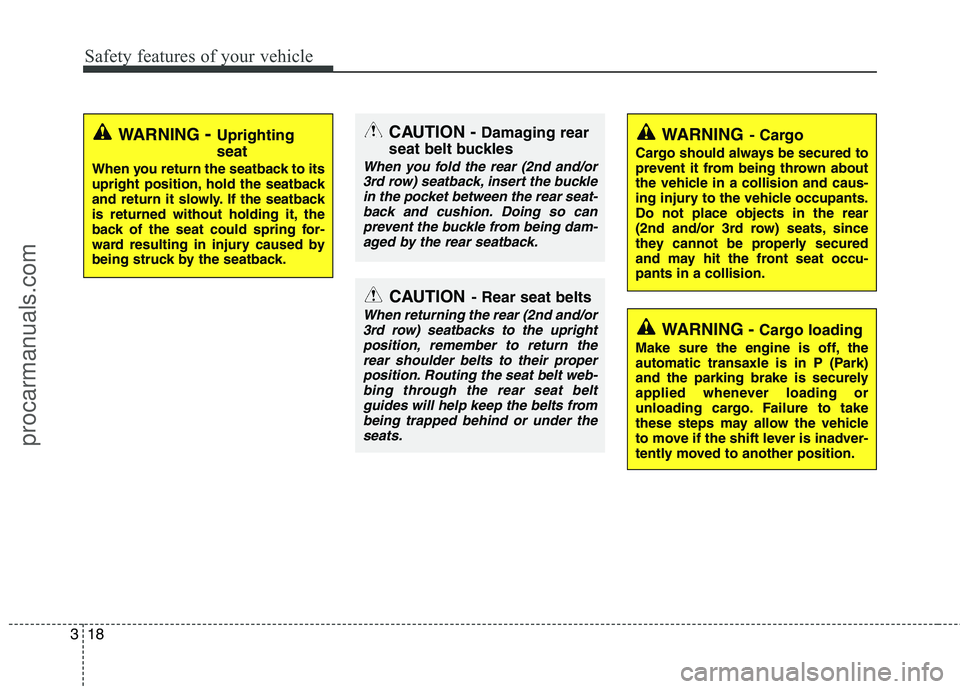
Safety features of your vehicle
18
3
CAUTION - Rear seat belts
When returning the rear (2nd and/or
3rd row) seatbacks to the upright
position, remember to return therear shoulder belts to their properposition. Routing the seat belt web- bing through the rear seat belt
guides will help keep the belts frombeing trapped behind or under theseats.
CAUTION - Damaging rear
seat belt buckles
When you fold the rear (2nd and/or 3rd row) seatback, insert the buckle
in the pocket between the rear seat-back and cushion. Doing so canprevent the buckle from being dam- aged by the rear seatback.
WARNING - Uprighting seat
When you return the seatback to its
upright position, hold the seatback
and return it slowly. If the seatback
is returned without holding it, the
back of the seat could spring for-
ward resulting in injury caused by
being struck by the seatback.
WARNING - Cargo loading
Make sure the engine is off, the
automatic transaxle is in P (Park)
and the parking brake is securely
applied whenever loading or
unloading cargo. Failure to take
these steps may allow the vehicle
to move if the shift lever is inadver-
tently moved to another position.
WARNING - Cargo
Cargo should always be secured to
prevent it from being thrown about
the vehicle in a collision and caus-
ing injury to the vehicle occupants.Do not place objects in the rear
(2nd and/or 3rd row) seats, since
they cannot be properly secured
and may hit the front seat occu-pants in a collision.
procarmanuals.com
Page 77 of 419
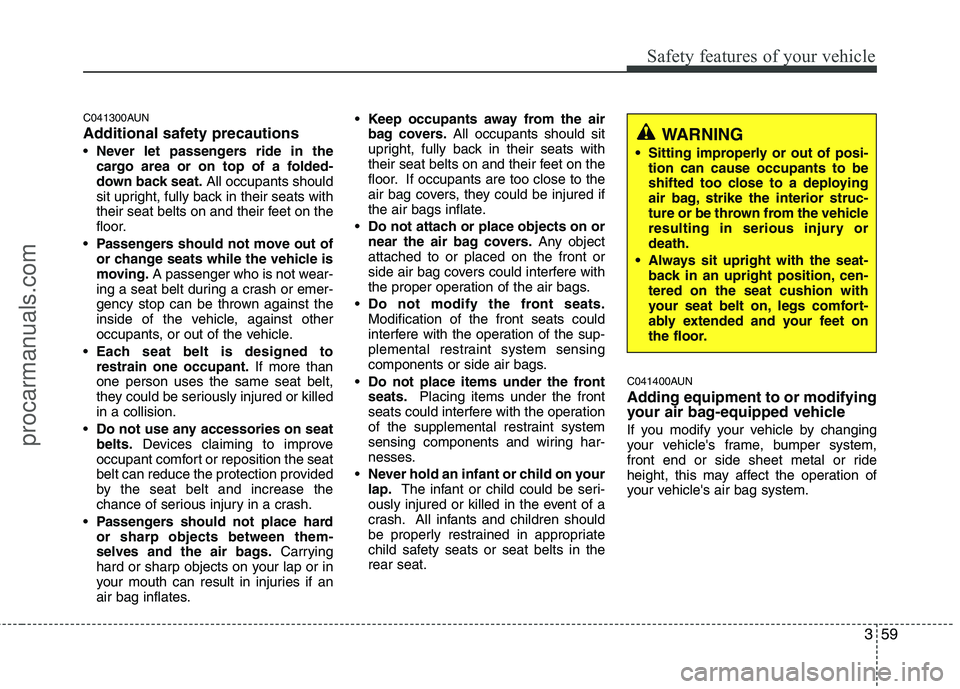
359
Safety features of your vehicle
C041300AUN
Additional safety precautionsNever let passengers ride in the
cargo area or on top of a folded-
down back seat. All occupants should
sit upright, fully back in their seats with
their seat belts on and their feet on the
floor.
Passengers should not move out of
or change seats while the vehicle is
moving. A passenger who is not wear-
ing a seat belt during a crash or emer-
gency stop can be thrown against the
inside of the vehicle, against other
occupants, or out of the vehicle.
Each seat belt is designed torestrain one occupant. If more than
one person uses the same seat belt,
they could be seriously injured or killedin a collision.
Do not use any accessories on seatbelts. Devices claiming to improve
occupant comfort or reposition the seat
belt can reduce the protection provided
by the seat belt and increase the
chance of serious injury in a crash.
Passengers should not place hardor sharp objects between them-
selves and the air bags. Carrying
hard or sharp objects on your lap or in
your mouth can result in injuries if an
air bag inflates.
Keep occupants away from the air
bag covers. All occupants should sit
upright, fully back in their seats with
their seat belts on and their feet on the
floor. If occupants are too close to the
air bag covers, they could be injured if
the air bags inflate.
Do not attach or place objects on or
near the air bag covers. Any object
attached to or placed on the front or
side air bag covers could interfere with
the proper operation of the air bags.
Do not modify the front seats.Modification of the front seats could
interfere with the operation of the sup-
plemental restraint system sensing
components or side air bags.
Do not place items under the frontseats. Placing items under the front
seats could interfere with the operation
of the supplemental restraint system
sensing components and wiring har-
nesses.
Never hold an infant or child on yourlap. The infant or child could be seri-
ously injured or killed in the event of a
crash. All infants and children should
be properly restrained in appropriate
child safety seats or seat belts in therear seat. C041400AUN
Adding equipment to or modifying
your air bag-equipped vehicle
If you modify your vehicle by changing
your vehicle's frame, bumper system,
front end or side sheet metal or ride
height, this may affect the operation of
your vehicle's air bag system.
WARNING
Sitting improperly or out of posi- tion can cause occupants to be
shifted too close to a deploying
air bag, strike the interior struc-
ture or be thrown from the vehicle
resulting in serious injury ordeath.
Always sit upright with the seat- back in an upright position, cen-tered on the seat cushion with
your seat belt on, legs comfort-
ably extended and your feet on
the floor.
procarmanuals.com
Page 92 of 419
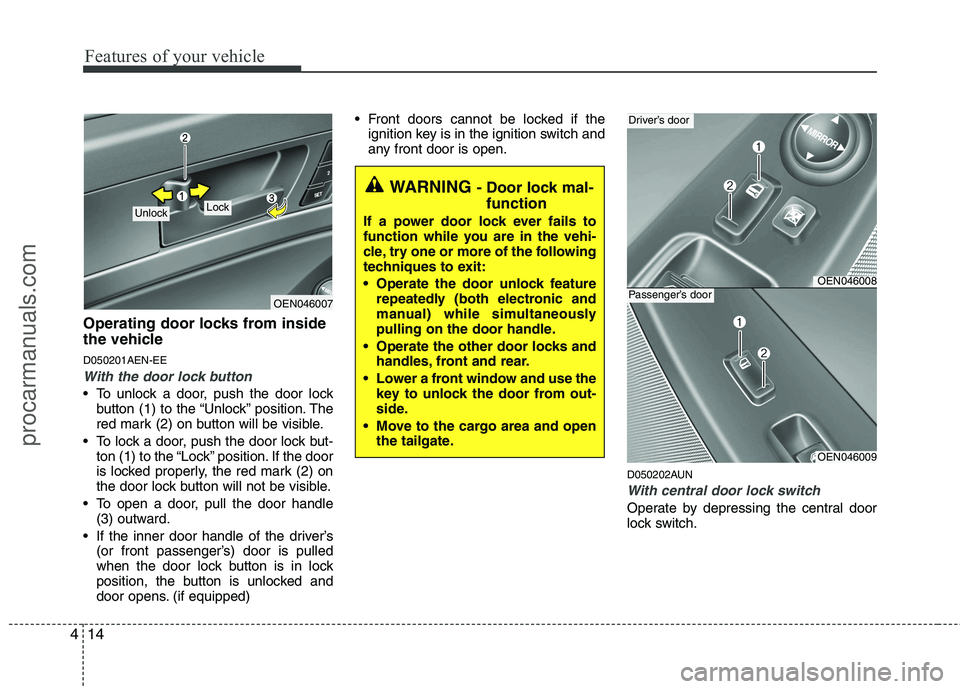
Features of your vehicle
14
4
Operating door locks from inside
the vehicle D050201AEN-EE
With the door lock button
To unlock a door, push the door lock
button (1) to the “Unlock” position. The
red mark (2) on button will be visible.
To lock a door, push the door lock but- ton (1) to the “Lock” position. If the door
is locked properly, the red mark (2) on
the door lock button will not be visible.
To open a door, pull the door handle (3) outward.
If the inner door handle of the driver’s (or front passenger’s) door is pulled
when the door lock button is in lock
position, the button is unlocked and
door opens. (if equipped) Front doors cannot be locked if the
ignition key is in the ignition switch and
any front door is open.
D050202AUN
With central door lock switch
Operate by depressing the central door
lock switch.
OEN046007
Lock Unlock
WARNING - Door lock mal-
function
If a power door lock ever fails to
function while you are in the vehi-
cle, try one or more of the following
techniques to exit:
Operate the door unlock feature repeatedly (both electronic and
manual) while simultaneously
pulling on the door handle.
Operate the other door locks and handles, front and rear.
Lower a front window and use the key to unlock the door from out-
side.
Move to the cargo area and open the tailgate.
OEN046008
Driver’s door
OEN046009
Passenger’s door
procarmanuals.com
Page 96 of 419
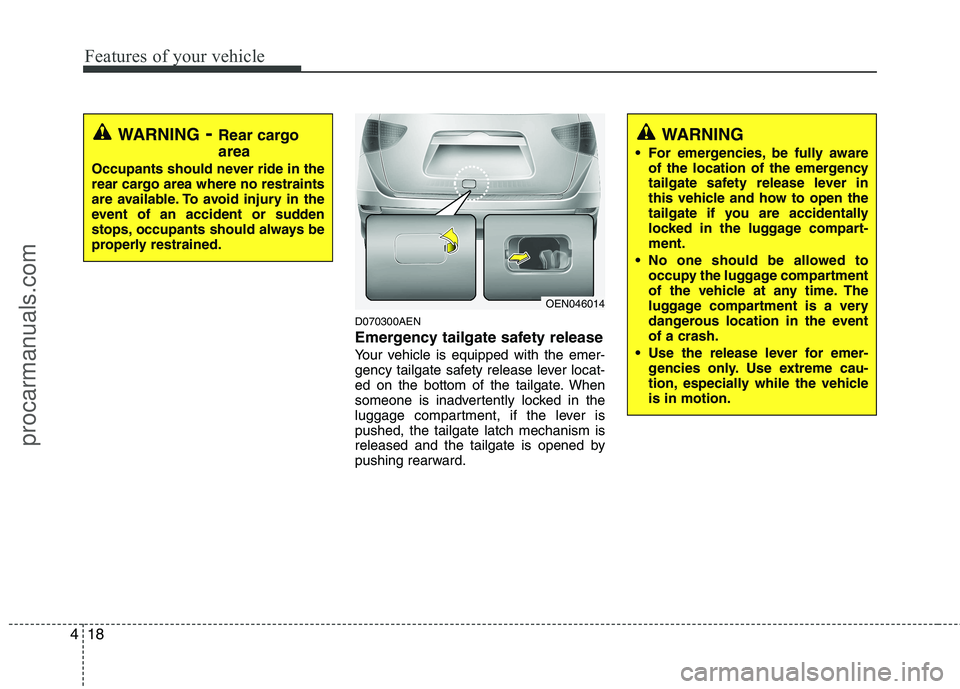
Features of your vehicle
18
4
D070300AEN
Emergency tailgate safety release
Your vehicle is equipped with the emer-
gency tailgate safety release lever locat-
ed on the bottom of the tailgate. When
someone is inadvertently locked in the
luggage compartment, if the lever ispushed, the tailgate latch mechanism is
released and the tailgate is opened by
pushing rearward.
WARNING
For emergencies, be fully aware of the location of the emergency
tailgate safety release lever in
this vehicle and how to open the
tailgate if you are accidentally
locked in the luggage compart-ment.
No one should be allowed to occupy the luggage compartment
of the vehicle at any time. The
luggage compartment is a very
dangerous location in the eventof a crash.
Use the release lever for emer- gencies only. Use extreme cau-
tion, especially while the vehicleis in motion.
OEN046014
WARNING - Rear cargo area
Occupants should never ride in the
rear cargo area where no restraints
are available. To avoid injury in the
event of an accident or sudden
stops, occupants should always be
properly restrained.
procarmanuals.com
Page 98 of 419

Features of your vehicle
20
4
✽✽
NOTICE
The power tailgate can be operated when the engine is not running.
However the power operation con-
sumes large amounts of vehicle elec-
tric power. To prevent the battery
from being discharged, do not operate
it excessively e.g.: more than approxi-
mately 10 times repeatedly.
To prevent the battery from being dis- charged, do not leave the power tail-
gate in the open position for a long
lime.
Do not apply excessive force while operating the power tailgate. This
could cause damage to the power tail-
gate.
Do not modify or repair any part of the power tailgate by yourself. This
must be done by an authorized
HYUNDAI dealer.
When jacking up the vehicle to change a tire or repair the vehicle, do
not operate the power tailgate. This
could cause the power tailgate to oper-
ate improperly.
D070401AEN
Automatic stop and reversal
If, during power opening or closing, the
tailgate is blocked by an object or part of
the body, the power tailgate will detect
the resistance, then the chime will sound
3 times, and it will stop movement or
move to the full open position to allow theobject to be cleared.
However, if the resistance is weak such as from an object that is thin or soft, orthe tailgate is near the latched position,
the automatic stop and reversal may notdetect the resistance and the closing
operation will continue. Also, if the power
tailgate is forced by a strong impact, the
automatic stop and reversal may oper-
ate. If the automatic stop and reversal feature
operates continuously more than twice
during one opening or closing operation,
the power tailgate may stop at that posi-
tion. At this time, close the tailgate man-
ually and operate the tailgate automati-cally again.
OEN036049
WARNING
Never intentionally place any object or part of your body in the
path of the power tailgate tomake sure the automatic stopoperates.
Make sure all faces, arms, hands, body parts and any other obstruc-
tions are safely out of the way
before operating the power tail-
gate.
Never place any object or part of your body in the path of the
power tailgate. This could result
in serious injury or cause dam-
age to the vehicle.
Make sure there are no people or objects around the tailgate before
operating the power tailgate.
Have rear passengers or cargo
get in or out of the vehicle only
after the tailgate is open fully andstopped.
procarmanuals.com